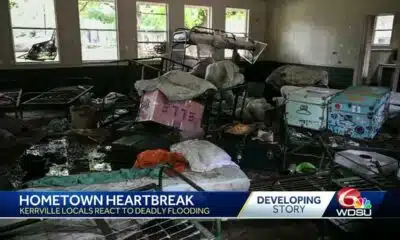News from the South - North Carolina News Feed
Why won’t Duke Energy just bury the lines? And other power restoration questions. Any looting in downtown Asheville? Why is the landfill still charging residents for storm debris? • Asheville Watchdog
Today’s batch of Helene questions and answers includes the motherlode of Duke Energy questions. Duke spokesperson Bill Norton answered these all in a flurry late last week, so I’m getting all five of them all out the door today, along with one question regarding reports of looting and another about the Buncombe County landfill.
Let’s get to the questions, a few smart-aleck yet tasteful responses, and the real answers:
Question: Without getting down to each nut and bolt that needs to be replaced, what specifically is preventing the power from being restored? Too many transmission lines down? What substations need to be completely rebuilt? Is this a manpower or money issue?
My answer: I remain incredulous that the human species survived — even thrived — for thousands of years without electricity. What a barbaric life that must have been.
Real answer: Norton noted that as of Friday Duke Energy had restored nearly 1.5 million customer outages in North Carolina from Hurricane Helene.
Norton said that as of 3:45 p.m. on Monday, Duke had 8,590 outages remaining, with 5,283 in Buncombe. At 10 a.m. on Monday, the numbers stood at 9,830 customers without power, with 6,684 in Buncombe County.
While numbers usually trend downward, Duke is seeing occasional upticks.
“We’re going to continue having some see-sawing like this as trees that are weakened but still standing come down when winds blow through,” Norton said. “Our vegetation crews are still working that ongoing challenge.”
To give you an idea of the progress Duke and the emergency crews from all over the country made here, as of noon Friday outages totaled 32,000 in the mountains, down from 49,000 the day before.
Now, about the difficulty inherent in these restoration efforts.
“Many areas of Western North Carolina were unreachable due to mudslides, flooding and blocked roads, limiting our ability to assess damage and make repairs, so we have also deployed drones and helicopters to assess and help with power restoration in inaccessible areas,” Norton said.
Norton said federal and state agencies, as well as local emergency responders, “have been invaluable in assisting with road access and other needs so our crews could get to work.”
“To highlight one example, NCDOT was able to build a temporary solution for a washed-out bridge in Haywood County, where power restoration is now complete,” Norton said, noting the outage map on Monday showed a single Haywood customer without power, a new outage first reported Monday.
Of course, the goal is to get the power back on to all remaining customers with outages. But it’s a huge job.
“Some will be restored within the coming days,” Norton said. “Other properties remain inaccessible or are not able to receive power — for reasons such as structural damage — and will be without electricity for an extended period of time. It’s going to take collaboration with local, state and federal agencies to get the job done, but we will not stop until everyone’s power is restored.”

Question 2: How much damage did the power grid sustain in Buncombe County? The rest of western North Carolina? By that, are major substations down? Or are we talking mostly just a lot of power lines down?
Answer: “The devastation of Hurricane Helene was unlike anything we have seen before in our history,” Norton said. “We experienced significant transmission, substation and power line damage, particularly in western North Carolina and Upstate South Carolina.”
Norton noted that Interstate highways were knocked out by Helene.
“Duke Energy’s version of the interstate, our transmission infrastructure, experienced significant damage too,” he said. “We focused on restoring this critical infrastructure first, along with essential facilities — emergency service and vital facilities such as Mission Hospital and the VA hospital in Asheville, law enforcement, fire departments and water treatment facilities.”
As an example, Norton noted that the transmission and distribution lines supporting the Town of Marion water treatment plant (in McDowell County) were washed away.
“The devastation was so severe that our crews working in the area couldn’t even find the poles,” Norton said. “Our crews worked night and day to rebuild the infrastructure and restore power to the water treatment plant by Oct. 3.”
Duke also brought in three mobile substations to replace flooded substations.
“That allowed us to restore power to the thousands of customers served by each, even as the substations must be fully rebuilt in the months ahead,” Norton said. “Overall, hundreds of substations were damaged — all were restored by Oct. 4 with the exception of the final two mobile substations, which came online on Oct. 7.”

Question 3: Why doesn’t Duke Energy just bury the power lines once and for all? I know it would be expensive, but wouldn’t that be better than lines going down during every major storm? How much does it cost to bury power lines?
Answer: First, Norton said that burying power lines “would not have prevented the catastrophic damage presented by Helene.”
“Every underground line is connected to an above-ground line somewhere, such as transmission lines and substations that cannot be buried and which were significantly damaged during this historic storm,” Norton said. “We often build underground lines in new construction, but it is not feasible to retroactively underground the majority of existing lines.”
About 20 years ago, the North Carolina Utilities Commission requested a study on what it would cost to run lines underground.
“Based on the results of its investigation, the NCUC public staff concluded that it was not feasible to replace the existing overhead distribution power lines with underground power lines,” Norton said. “Such an undertaking would have cost approximately $41 billion and would take a workforce of nearly 5,000 employees 25 years to complete the project — keep in mind that was in 2003 dollars, and prior to the major population growth experienced by North Carolina.”
As you might have suspected, our mountains pose another challenge.
“Looking at the mountains specifically, undergrounding lines through the significant rock in this area costs about 10 times as much as elsewhere in the state, and undergrounding would also require massive tree removal to bury lines where tree roots are today,” Norton said. “For all those reasons and more, it’s not a feasible solution.”

Question 4: On Monday, Sept. 30, I drove by the Asheville Outlets mall. There, and in adjacent business lots, I saw dozens of powerline service trucks and trucks for tree services sitting idly. In several cases, affiliated workers were standing around. Given the immensity of the need in the area, I’m curious about this. I live in the Kenilworth area, and several major roads were still blocked, many large trees were down, with power lines scattered around. And of course, we still do not have electricity (power was restored to Kenilworth this past weekend). I understand the importance of a triaged approach to all of this, but I wonder why it is not possible to utilize resources that are here, ready and waiting.
Answer: “Immediately after a storm blows through, damage assessment is the first step so we can determine exactly what type of crews, equipment and materials are needed before we deploy crews to a specific site,” Norton said. “This helps us efficiently identify the right types of crews (line, tree, etc.) and have the right materials and equipment to get to work on repairs. You’ll often see line crews getting organized at staging areas while this initial assessment is being undertaken by damage assessors.”
Norton pointed out that the damage assessors, vegetation crews, and line workers have been “working 16-hour days for two solid weeks to get customer power on, typically leaving these staging areas before dawn and returning after sunset.”
“During the initial phase of the storm when communication networks were down, line trucks had to return to base operations more often than you’d see in a typical storm to get new assignments and map out routes by hand since GPS wasn’t working,” Norton said. “Additionally, crews do need to rest and refuel — both for themselves and their equipment. Working with electricity is hazardous work, and keeping line workers rested and alert is vital for safe power restoration.”
On a personal note, I’d like to thank these line crews for coming in from all over the country and busting their rear ends to restore power. It’s been an amazing effort.

Question 5: We’re a homeowners association of Cedar View and Ridge View just off Lovers Loop, and we seem to have fallen off Duke’s maps for repairs. Our 29 houses remain dark while those around us have power. Duke’s power outage maps are incorrect. A number of us have been calling and getting nowhere. Colder weather is forecast in the coming days. We’ve been working hard clearing the roads but nothing from Duke. I wonder if you can get Duke’s attention.
Answer: Consider it gotten.
“When repairs are made to a large outage affecting thousands of customers, that repair is considered ‘complete’ in our system, which automatically triggers an alert to all affected customers,” Norton said. “There may, however, still be a smaller problem that requires repair before power can be restored to your home.”
If you get a “repairs completed” text and your power is still out, Norton said to simply reply “OFF” to let Duke know your power is still out.
“This will help us isolate the piece of equipment still in need of repair and get your power restored,” Norton said.

Question: I love my friend dearly, and normally this friend is a reliable source of information. But this person owns a store in downtown Asheville, and she has received reports of looting by “vagrants” of closed stores in Asheville. Please confirm or refute this information. It is not my friend’s personal knowledge. It is a report from an employee. I have suggested she call the police or Chamber of Commerce to verify the report, but I don’t believe she will. This is the kind of news that can spread quickly as misinformation, and I hate this could be true.
My answer: Well, at least no one has tried to politicize this immense human tragedy for political gain.
Real answer: “After reviewing our records, and discussing with leadership, there have not been reports of looting by ‘vagrants,’ as you put it,” Asheville Police Department spokesperson Rick Rice said via email. “There have been some reports of larceny and of breaking and entering, but no more than occurs under normal circumstances.”
I’d like to note that “vagrants” was not my word. Just covering my rear end here.
“There are no reports in our system of looting downtown that I can find, but if your friend or anyone knows of it occurring, we would encourage them to contact the APD and file a report so it can be investigated,” Rice said.
I’ll also note this question came from a reader I do not personally know.
Other parts of town did see some looting, Rice noted.
“There were some instances of looting in the immediate aftermath of the storm, but those occurred at box stores and other retail outlets located outside downtown,” Rice said. “There were two instances where arrests were made while a theft was being attempted, and we issued press releases on both.”

Question: My house has been pretty much destroyed, as have so many others. We have sent five truckloads of debris to The Buncombe County Landfill. Can you please tell me why they haven’t waived their fees during this tragedy? Every time we go, I get madder and madder at this seemingly small thing. However it totally upsets me that they are not working with us.
My answer: I shall offer no sarcasm here, as this has got to be incredibly frustrating under the circumstances.
Real answer: Buncombe County spokesperson Kassi Day said this situation gets a little complicated.
“While we have temporarily waived residential bagged trash fees at the transfer station, we cannot afford to waive commercial tipping fees for construction waste and other debris,” Day said via email. “Solid Waste is an ‘enterprise’ fund, which means it is supported by fees and is not intended to be subsidized by tax revenue. FEMA will not reimburse the county for waived tipping fees.”
Day said the county is collecting debris from “critical infrastructure, such as hospitals, schools, and water facilities.”
“We are still assessing the total volume of debris before we start a broader collection effort,” Day said. “Once we know the scope, we will begin to clear all public roadways. Then the county will begin collecting residential debris that people have placed in the right-of-way along public roads.”
Day said people can start placing debris there now, with an important addendum.
“This is important: It will speed up collection for all of us if everyone separates their debris by type,” Day said. “Appliances, construction materials, electronics, and hazardous household materials (herbicides, paint, small propane tanks, solvents) should be placed into separate piles.”
Day said the county has contracted with a removal company to provide the collection. The county hopes to have more information to share with the public this week, she added.
Asheville Watchdog is a nonprofit news team producing stories that matter to Asheville and Buncombe County. John Boyle has been covering Asheville and surrounding communities since the 20th century. You can reach him at (828) 337-0941, or via email at jboyle@avlwatchdog.org. To show your support for this vital public service go to avlwatchdog.org/support-our-publication/.
Related
The post Why won’t Duke Energy just bury the lines? And other power restoration questions. Any looting in downtown Asheville? Why is the landfill still charging residents for storm debris? • Asheville Watchdog appeared first on avlwatchdog.org
News from the South - North Carolina News Feed
PETA sues American Kennel Club over standards for French bulldogs, other breeds
SUMMARY: PETA is suing the American Kennel Club (AKC) over breeding standards for popular dog breeds like French bulldogs, pugs, and dachshunds. PETA argues these standards promote unhealthy traits causing lifelong suffering, such as bulldogs’ large skulls and shortened faces that impede breathing. The lawsuit cites UK research showing French bulldogs have poorer health, and notes the Netherlands banned breeding short-nosed dogs. Dachshunds’ long backs and short legs also lead to painful conditions. The AKC rejects PETA’s claims, stating it is committed to dogs’ health and well-being. This lawsuit continues a long-standing conflict between PETA and the AKC.
The animal rights group PETA sued Tuesday to try to force the American Kennel Club to abandon the standards it backs for hyper-popular French bulldogs and some other breeds, contending that the influential club is promoting unhealthy physical features.
More: https://abc11.com/post/peta-sues-american-kennel-club-breeding-standards-french-bulldogs-other-breeds/17038437/
Download: https://abc11.com/apps/
Like us on Facebook: https://www.facebook.com/ABC11/
Instagram: https://www.instagram.com/abc11_wtvd/
Threads: https://www.threads.net/@abc11_wtvd
TIKTOK: https://www.tiktok.com/@abc11_eyewitnessnews
News from the South - North Carolina News Feed
Boil water notice lifted in Hillsborough
SUMMARY: Hillsboro has lifted its boil water advisory, but the city and nearby Mebban still face water challenges following heavy rain from Shantel. Mebban closed non-essential businesses to conserve water as their treatment plant remains unrepaired with no clear fix timeline, leaving under two days of drinking water. Hillsboro’s plant was overwhelmed, causing multiple sanitary sewer overflows and flooding, releasing 174,000 gallons of sewage into Kate’s Creek. Repair efforts continue, with the main clear well sanitized and refilling, but full testing delays reopening. Meanwhile, Hillsboro relies on water from Durham and urges residents to conserve amid potential further storms that may worsen the situation.
Hillsborough’s boil water notice has been lifted, but the town’s water system remains vulnerable as its main treatment plant is offline.
News from the South - North Carolina News Feed
AdventHealth makes its most public case for building region’s second-largest hospital, but has yet to ask the state for permission
Months before it can get official permission from the state, Florida-based nonprofit AdventHealth is seeking public support for a 129-bed expansion of its already approved 93-bed new hospital under construction in northern Buncombe County.
Coupled with an earlier, pending certificate of need (CON) request to the state for 26 additional beds, AdventHealth will be proposing a total of 222 acute care beds for the new facility in Weaverville, making it — if approved by state regulators, and if it withstands possible challenges from Nashville-based for-profit HCA Healthcare — the second-largest hospital in western North Carolina and the first major competitor to HCA Mission Health’s near-monopoly on hospital services in Buncombe County.
Mission Hospital in Asheville has 682 licensed acute-care beds. UNC Health Pardee in Henderson County has 201. The Charles George VA Medical Center in Buncombe County has 119. AdventHealth already operates a 62-bed hospital in Henderson County, according to the Proposed 2026 State Medical Facilities Plan.

For months, AdventHealth, a Seventh-day Adventist nonprofit that is the largest Christian-based nonprofit hospital system in the United States, quietly has been pitching a proposal for the additional 129 beds to local leaders across the region. But this week’s public announcement of plans marks the first significant indication of AdventHealth’s vision for a much larger facility.
The announcement, however, comes months before any possible official action.
Applications for the additional 129 beds cannot be submitted to the state until Oct. 15, according to the 2025 State Medical Facilities Plan. AdventHealth, which owns more than 50 hospitals across the nation, has been gathering letters of support from town councils, health departments and residents in preparation for its application.
It’s already started grading work at the 30-plus acre site and is planning a groundbreaking ceremony later this year. When AdventHealth first applied for the project, the nonprofit told the North Carolina Department of Health and Human Services’ Division of Health Service Regulation (DHSR) it would cost $254 million. Plans to expand the hospital will inflate the price, AdventHealth spokesperson Victoria Dunkle said.
“We will be sharing the updated scope, scale and costs in the final application,” she said.
Though AdventHealth originally said the hospital would open by 2027, expansion and a complex application process make that aspiration unlikely.
Weaverville Mayor Patrick Fitzsimmons said that although the delays are frustrating, the prospect of a large new hospital is welcome in this town of about 4,500.
“This is a positive development for our town,” Fitzsimmons said. “We’re talking about the addition of maybe as many as a couple thousand jobs as these new hospital beds are allotted, the kind we’re trying to attract to Weaverville.”
Service area: Buncombe, Graham, Madison and Yancey
Meant to serve patients in Buncombe, Graham, Madison and Yancey counties, the facility originally was slated for only 67 beds, according to the certificate of need application AdventHealth filed in 2022, which was approved by the state months later, despite competition and opposition from other big health care systems, including the HCA Healthcare-owned Mission Health system.
North Carolina’s CON law forces medical facilities to compete when they want to expand, add services, or buy expensive equipment. Organizations apply for projects and the state decides whether they are necessary.
In 2024 Advent added an application for 26 more beds to its original bid, bringing the total it was asking to 93. The extra 129 beds proposed this week would more than double the total bed count at the proposed Weaverville hospital.
“With 222 beds, the community will have more access to higher-level emergency and specialty care and more choices for how and where to receive this advanced care,” the release said, touting “not-for-profit, whole-person care” and “the growing needs of our region.”

Though a thumbs-up from the DHSR, the entity responsible for approving applications, is the first step to getting those beds, it’s hardly the last. CON law allows other hospitals to appeal the DHSR decision repeatedly, which Mission Health has done with all of AdventHealth’s previous approvals for the hospital. Last month an appellate court judge ruled against HCA-Mission’s most recent challenge to the 67-bed bid, which the DHSR approved more than three years ago.
Mission Health spokesperson Katie Czerwinski declined comment on Mission’s appeals. She did not respond to a question about whether Mission would also apply for the 129 beds come October.
HCA also challenges 26-bed AdventHealth award
AdventHealth’s announcement Monday highlighted the North Carolina Court of Appeals decision to finally greenlight the 67 beds, opposing Mission Health’s contention since 2022 that it didn’t get a fair shake in the CON process. Both Mission and Novant Health tried to win the beds that year.
“AdventHealth is grateful for the North Carolina Court of Appeals’ decision to uphold the State’s approval of our CON application for a 67-bed hospital in Buncombe County,” the news release said.
Because of CON laws and Mission’s legal contentions, AdventHealth is far from clear to finalize its vision of opening what would be one of the region’s largest hospitals by acute-care-bed count. Although the battle over the 67 beds is over now, another one is waiting on an Office of Administrative Hearings judge’s decision. Mission Health filed an appeal Dec. 20, 2024, stating that AdventHealth’s 26-bed application was erroneously granted to AdventHealth.
“By denying Mission a CON for the Mission Application, the Agency’s Decision prevents Mission from expanding Mission Hospital to meet the needs of Mission’s existing and future patients and therefore directly limits Mission’s ability to engage in its lawful business,” the appeal said.
AdventHealth did not mention the 26 beds in its release.
“The 26-bed approval is currently under appeal by a competitor,” AdventHealth spokesperson Victoria Dunkle said Tuesday. “That appeal is being reviewed through the Office of Administrative Hearings. Despite this delay, we remain steadfast in our commitment to bring these 93 beds — and the whole-person care they represent — to the people of Western North Carolina. We are confident that the State’s original decision will be upheld, and we continue to prepare to deliver on that promise.”
An effort to repeal CON laws, Senate Bill 370, made headway in the General Assembly this April. But that effort may be overshadowed by a 2020 lawsuit brought by a New Bern vision physician, Jay Singleton, in the state’s Supreme Court, arguing the multilayered application process “has nothing to do with protecting the health or safety of real patients.”
Currently, 34 other states have similar CON laws.
“Proponents of CON laws contend that if excess health care service capacity exists, price inflation may occur to compensate for new, underused health care services or empty beds,” according to a summary by the National Conference of State Legislators. “Opponents believe CON laws stifle competition by protecting incumbent providers and creating a burdensome approval process for establishing new facilities and services.”
Asheville Watchdog welcomes thoughtful reader comments on this story, which has been republished on our Facebook page. Please submit your comments there.
Asheville Watchdog is a nonprofit news team producing stories that matter to Asheville and Buncombe County. Andrew R. Jones is a Watchdog investigative reporter. Email arjones@avlwatchdog.org. The Watchdog’s local reporting is made possible by donations from the community. To show your support for this vital public service go to avlwatchdog.org/support-our-publication/.
Related
The post AdventHealth makes its most public case for building region’s second-largest hospital, but has yet to ask the state for permission appeared first on avlwatchdog.org
Note: The following A.I. based commentary is not part of the original article, reproduced above, but is offered in the hopes that it will promote greater media literacy and critical thinking, by making any potential bias more visible to the reader –Staff Editor.
Political Bias Rating: Centrist
This content offers a straightforward, fact-based report on AdventHealth’s hospital expansion plans and the surrounding regulatory and legal environment. It primarily focuses on healthcare infrastructure development, regulatory processes, and competition dynamics without expressing partisan opinions or ideological viewpoints. The article presents multiple perspectives, including that of AdventHealth, its competitors, local officials, and regulatory authorities, maintaining an objective tone typical of centrist reporting.
-
News from the South - Arkansas News Feed6 days ago
Real-life Uncle Sam's descendants live in Arkansas
-
News from the South - Louisiana News Feed7 days ago
Her son faced 10 years behind bars; now she’s the one facing prison
-
News from the South - Arkansas News Feed7 days ago
Could roundabouts become more common than red lights?
-
News from the South - Georgia News Feed5 days ago
'Big Beautiful Bill' already felt at Georgia state parks | FOX 5 News
-
News from the South - Oklahoma News Feed6 days ago
LOFT report uncovers what led to multi-million dollar budget shortfall
-
News from the South - Alabama News Feed7 days ago
Alabama schools to lose $68 million in federal grants under Trump freeze
-
News from the South - Missouri News Feed7 days ago
Celebrate St. Louis returns with new Superman-themed drone show
-
News from the South - Tennessee News Feed6 days ago
Officers run for cover after man in car fired shots at them in Downtown Memphis









































